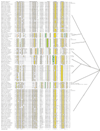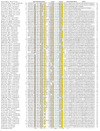New connections in the prokaryotic toxin-antitoxin network: relationship with the eukaryotic nonsense-mediated RNA decay system
- PMID: 14659018
- PMCID: PMC329420
- DOI: 10.1186/gb-2003-4-12-r81
New connections in the prokaryotic toxin-antitoxin network: relationship with the eukaryotic nonsense-mediated RNA decay system
Abstract
Background: Several prokaryotic plasmids maintain themselves in their hosts by means of diverse post-segregational cell killing systems. Recent findings suggest that chromosomally encoded copies of toxins and antitoxins of post-segregational cell killing systems - such as the RelE system - might function as regulatory switches under stress conditions. The RelE toxin cleaves ribosome-associated transcripts, whereas another post-segregational cell killing toxin, ParE, functions as a gyrase inhibitor.
Results: Using sequence profile analysis we were able unify the RelE- and ParE-type toxins with several families of small, uncharacterized proteins from diverse bacteria and archaea into a single superfamily. Gene neighborhood analysis showed that the majority of these proteins were encoded by genes in characteristic neighborhoods, in which genes encoding toxins always co-occurred with genes encoding transcription factors that are also antitoxins. The transcription factors accompanying the RelE/ParE superfamily may belong to unrelated or distantly related superfamilies, however. We used this conserved neighborhood template to transitively search genomes and identify novel post-segregational cell killing-related systems. One of these novel systems, observed in several prokaryotes, contained a predicted toxin with a PilT-N terminal (PIN) domain, which is also found in proteins of the eukaryotic nonsense-mediated RNA decay system. These searches also identified novel transcription factors (antitoxins) in post-segregational cell killing systems. Furthermore, the toxin Doc defines a potential metalloenzyme superfamily, with novel representatives in bacteria, archaea and eukaryotes, that probably acts on nucleic acids.
Conclusions: The tightly maintained gene neighborhoods of post-segregational cell killing-related systems appear to have evolved by in situ displacement of genes for toxins or antitoxins by functionally equivalent but evolutionarily unrelated genes. We predict that the novel post-segregational cell killing-related systems containing a PilT-N terminal domain toxin and the eukaryotic nonsense-mediated RNA decay system are likely to function via a common mechanism, in which the PilT-N terminal domain cleaves ribosome-associated transcripts. The core of the eukaryotic nonsense-mediated RNA decay system has probably evolved from a post-segregational cell killing-related system.
Figures






References
MeSH terms
Substances
LinkOut - more resources
Full Text Sources
Other Literature Sources
Molecular Biology Databases

